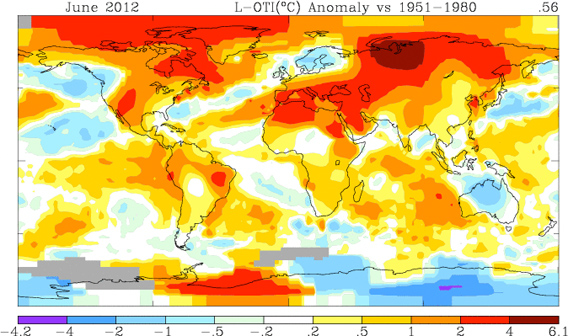
As the world experiences record heat, increased drought and fires, unprecedented ice melt and similar extreme weather anomalies decades before expected, climatologists have been forced to reconsider previous climate change projections and research techniques.
Less than a decade ago, scientific consensus considered warming of more than 2°C (3.6°F) and atmospheric levels of carbon dioxide near 450 parts per million (ppm) as acceptable or “safe”. Revised climate science literature and expert opinion now regard safe atmospheric levels of carbon dioxide as below 350 ppm, or less than 1°C (1.8°F) rise in average planetary temperature. Many researchers and environmentalists, however, recognize that the present deviation from pre-industrial temperatures of 0.8°C (1.4°F) may be unacceptable to prevent runaway climate change and widespread disasters.
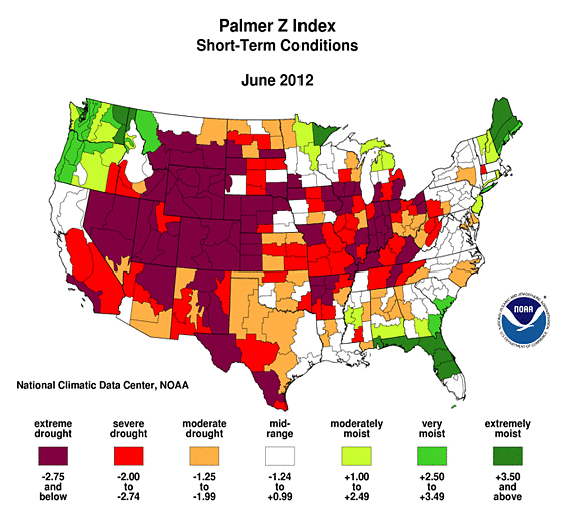
In a 2011 publication, NASA climate expert James Hansen and co-author Makiko Sato conclude, “Augmentation of peak Holocene temperature by even 1C would be sufficient to trigger powerful amplifying polar feedbacks, leading to a planet at least as warm as in the Eemian and Holsteinian periods, making ice sheet disintegration and large sea level rise inevitable.”
Continuous, modern day observations of change suggest the Earth System may already be edging towards abrupt climate change, demanding thorough revisions to climate science, models, and action.
For instance, the amount of warming require to commit Greenland’s current ice sheet to complete melt-off has been updated from 3.1 °C (1.9-5.1 °C, 95% confidence interval) above pre-industrial temperature to an estimated 1.6 °C (0.8-3.2 °C) rise. Greenland and Antarctica’s ice sheets are already thinning faster than they are being replaced, with melt levels nearly 100 years ahead of 2001 predictions by the Intergovernmental Panel on Climate Change (IPCC).
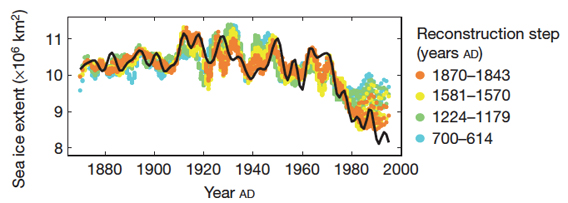
Observed ice extent record (black) over the 1870–1995 calibration interval and ice extent predicted by the reduced calibration sets during cross-validation, for four distinct reconstruction steps. Image and caption courtesy of Nature. Click image to enlarge.
Additionally, regions of the Arctic north of Alaska indicate rapid warming signifying what researches describe as the “Arctic (or Polar) amplification effect.” The effect leads to rapid warming in Polar Regions, in turn accelerating faster than elsewhere on the globe.
The effects of warming are noticeable far beyond Polar Regions. This June, more than 3,215 high-temperature records were broken or tied in the US. A recent study issued in Nature Geoscience indicates the ongoing drought conditions in the US are “the worst in 800 years,” and may be the onset of a prolonged, chronic “megadrought.” Meanwhile, extreme temperatures are feeding major wildfires in Siberia expected to last through the summer.
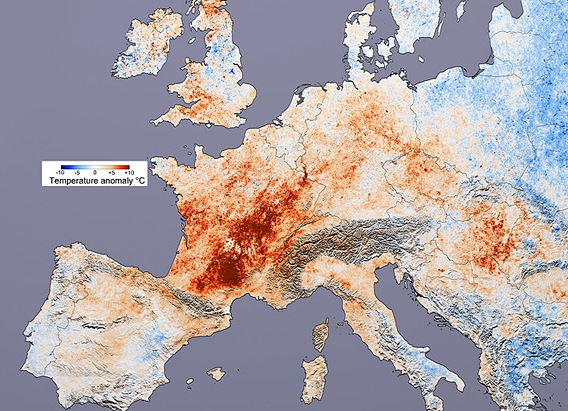
Hitting France especially hard, the Europe 2003 heatwave left tens of thousands of people dead. A new statistical analysis argues that climate change was the cause of this and other extreme summer heat events. Image by: NASA.
Food, energy, and global economic systems appear exceedingly sensitive to the systemic shocks of extreme weather. Unable to manage the strain of increased power demand due to high heat, electrical grids serving over 600 million people in India collapsed earlier this week. Analysts suggest the ongoing drought conditions in the Midwestern US may contribute to substantial increases in global food prices and social distress.
Present day effects of climate change have already been linked to widely destructive events, and suggest the initiation of abrupt climate change.
The National Research Council (NRC) identifies abrupt climate changes as periods “occurring when the climate system is forced to cross some threshold, triggering a transition to a new state at a rate determined by the climate system itself and faster than the cause.” Abrupt climate change may be regional, hemispheric, or global. Although great leaps have been made in modeling, data interpretation and research, the study of abrupt climate change is still in its infancy. Experimental techniques, computer models, and measurement devices are not only under scrutiny, but human and group psychology. To more precisely comprehend the consistent underestimation of the severity of resource and climate issues, the studies of environmental psychology and sociobiology are increasingly sought.
The global nature of climate change requires that adaptive measures be pursued and shared throughout all world cultures. Leaps in networking, open information forums and coordinated direct action have demonstrated fast, replicable responses and mitigation strategies. Activist and research platforms featuring an enormous breadth of topics ranging from Do-it-Yourself state failure management to decentralized, carbon-negative applications may be accessed and adopted by the online community, and are being introduced throughout communities effected by environmental disasters worldwide.
Although the task of managing the Earth System’s carbon balance appears unapproachable through conventional politics, a wide range of scientific collaborations and community-level ecological restoration efforts are already well underway. In many instances localized environmental renewal initiatives may provide immediate benefits to impoverished regions as well as provide long-term frameworks for climate change adaptation and mitigation.
Biochar, for instance, is recognized as one of the most potentially powerful carbon sequestration techniques and has quickly gained popularity around the world. The production of charcoal from plant biomass (“biochar” or “terra preta”) is considered to be one of the most effective and globally-scalable carbon-negative techniques. Biochar additionally provides a wide range of benefits for nutrient and water cycling in many soils.
Biochar is by no means a panacea to the massive upset of the carbon cycle resulting from human activities. The technique, however, does exemplify a framework for post-industrial ecological restoration techniques. As opposed to expensive, spurious quick-fix geoengineering schemes, these sorts of applications approach global change issues through an alternative model. Instead of tax-payer dependent, high-tech gimmicks requiring huge amounts of funding and research that may be applied only by highly specialized experts, the production and effects of biochar may be studied by virtually anyone, anywhere. Biochar techniques lend themselves to information sharing and networked, collaborative study.
Simple, replicable soil application experiments with biochar have been conducted and submitted for analysis and review to a wide variety of online social networks. Biochar projects have found support through modest “crowdfunding” efforts in addition to large-scale production for profit. With increasing evidence of the systemic threats posed by abrupt climate change, techniques able to rapidly adapt to wildly changing conditions will likely flourish.
The framework of scalable network systems that begin with few nodes capable of swift multiplication and responsive to novel information and conditions provides the generalized context for organizational structures suitable to modern climate and global change circumstances.

Related articles
Extreme heatwaves 50 to 100 times more likely due to climate change
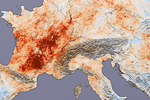
(08/05/2012) A recent rise in deadly, debilitating, and expensive heatwaves was caused by climate change, argues a new statistical analysis published in the Proceedings of the National Academy of Sciences (PNAS). Climatologists found that extreme heatwaves have increased by at least 50 times during the last 30 years. The researchers, including James Hansen of NASA, conclude that climate change is the only explanation for such a statistical jump.
Prominent climate skeptic reverses course, says global warming worse than IPCC forecast
(07/30/2012) After starting his own project to study global warming, a once-prominent climate change skeptic and physicist says he now accepts the reality of anthropogenic climate change. “Last year, following an intensive research effort involving a dozen scientists, I concluded that global warming was real and that the prior estimates of the rate of warming were correct. I’m now going a step further: Humans are almost entirely the cause,” Richard Muller writes in the New York Times as his team, the Berkeley Earth Project, releases a new paper that finds an even stronger link between greenhouse gas emissions and rising temperatures worldwide than the Intergovernmental Panel on Climate Change (IPCC).
U.S. drought could set in motion global food crisis
(07/23/2012) The U.S. is suffering drought levels not seen in over 50 years—and drawing comparisons to the Dust Bowl—with 56 percent of the contiguous U.S. in moderate to extreme drought. Some experts fear that the drought, and resulting hikes in food prices, could propel another global food crisis like those seen in 2008 and 2010.
Republican stalwart calls global warming ‘a matter of fact’, pushes for carbon tax
(07/13/2012) Former Secretary of State George Shultz is calling for a carbon tax to reduce U.S. greenhouse gas emissions and oil consumption, according to an interview released today by Stanford University.
Deja vu: U.S. undergoes hottest 12 months on record…again and again
(07/12/2012) According to new data from the National Oceanic and Atmospheric Administration (NOAA)’s National Climatic Data Center, the last twelve months have been the warmest on record for the contiguous United States. This record, set between July 2011 through June 2012, beat the last consecutive twelve month record set only a month earlier between June 2011 and May 2012, which in turn beat the previous record holder, you guessed it: May 2011 through April 2012.
Climate change increased the probability of Texas drought, African famine, and other extreme weather
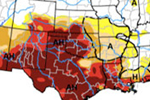
(07/11/2012) Climate change is here and its increasing the chances for crazy weather, according to scientists. A prestigious group of climatologists have released a landmark report that makes the dramatic point that climate change is impacting our weather systems—and in turn our food crops, our economies, and even our lives—here-and-now. The new report in the American Meteorological Society is first of what is intended to be an annual offering that will attempt to tease out the connections between climate change and individual extreme weather events, such as heatwaves, droughts and floods.
As U.S. sees record heat, extreme weather pummels 4 continents

(07/10/2012) It’s not only the U.S. that has experienced record-breaking extreme weather events recently, in the last couple months extreme weather has struck around the world with startling ferocity. In addition to the much-covered heatwaves, wildfires, and droughts in the U.S., killer floods struck India, the worst drought yet recorded plagued South Korea, and massive forest fires swept through Siberia to name just a few.